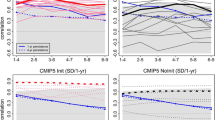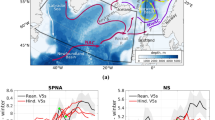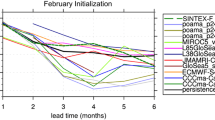Abstract
The quality of a multimodel of six coupled climate forecast systems initialized with observations—relative to the accompanying uninitialized system—to re-forecast the future annual-mean North Atlantic sea surface temperature (SST) departures is described. The study concludes that, measured by the anomaly correlation (AC) skill, the evolution of the leading two empirical orthogonal function modes of North Atlantic SSTs are skillfully forecast throughout the 9-year forecast range. This skill results in part from the predictions of the trend. The skill of the detrended modes, i.e., in absence of SST variability generated by the trend, is reduced, but still statistically distinguishable from zero throughout the 9-year forecast for the first mode and exclusively in the first two forecast years for the second mode. The initialization effect on the AC skill in the initialized system is statistically distinguishable from the one without initialization for the detrended first mode during the first three forecast years and the first forecast year only when the trend in North Atlantic SSTs is included. All six initialized systems of the multimodel are capable to skillfully forecast the shift of the full first mode of North Atlantic SST anomalies in the mid 1990s at all leads with HadCM 3 and EC-Earth 2.3 outperforming other systems. All systems share an intrinsic bias in simulating annual-mean SST variability in the North Atlantic. The study finds that the area-average AC skill (i.e., of a forecast containing regional information) of the North Atlantic influence on anomalous European temperature in the initialized multimodel is positive and statistically distinguishable from zero throughout the 9-year forecast for the full field case. On the other hand, a continent-wide forecast (i.e., without any regional information) of future European precipitation departures associated with North Atlantic SST variability is skillful throughout the 9-year forecast for the full field case—once the model remote influence is corrected by the observed. For the detrended case, the forecasts of the influence of the North Atlantic SSTs on both interannual temperature and precipitation departures in Europe show residual skill—which means that the multimodel is able to predict part of them beyond the trend. However, the forecasts of the North Atlantic influence on precipitation departures in the Sahel turn out not to be skillful.















Similar content being viewed by others
References
Alexander MA, Bladé I, Newman M, Lanzante JR, Lau NC, Scott JD (2002) The atmospheric bridge: the influence of enso teleconnections on air–sea interaction over the global oceans. J Clim 15:2205–2231
Barnston AG, van den Dool HM, Rodenhuis DR, Ropelewski CR, Kousky VE, O’Lenic EA, Livezey RE, Zebiak SE, Cane MA, Barnett TP et al (1994) Long-lead seasonal forecasts—where do we stand? Bull Am Meteorol Soc 75(11):2097–2114
Boer GJ (2004) Long time-scale potential predictability in an ensemble of coupled climate models. Clim Dyn 23:29–44. doi:10.1007/s00382-004-0419-8
Booth BB, Dunstone NJ, Halloran PR, Andrews T, Bellouin N (2012) Aerosols implicated as a prime driver of twentieth-century North Atlantic climate variability. Nature 484(7393):228–232
Branstator G, Teng H, Meehl GA, Kimoto M, Knight JR, Latif M, Rosati A (2012) Systematic estimates of initial-value decadal predictability for six AOGCMs. J Clim 25(6):1827–1846
Brohan P, Kennedy JJ, Harris I, Tett SFB, Jones PD (2006) Uncertainty estimates in regional and global observed temperature changes: a new data set from 1850. J Geophys Res 111(D12):106
Chikamoto Y, Kimoto M, Watanabe M, Ishii M, Mochizuki T (2012) Relationship between the Pacific and Atlantic stepwise climate change during the 1990s. Geophys Res Lett 39:L21710. doi:10.1029/2012GL053901
Chikamoto Y, Kimoto M, Ishii M, Mochizuki T, Sakamoto TT, Tatebe H, Komuro Y, Watanabe M, Nozawa T, Shiogama H, et al (2013) An overview of decadal climate predictability in a multi-model ensemble by climate model MIROC. Clim Dyn 40(5):1201–1222. doi:10.1007/s00382-012-1351-y
Deser C, Blackmon ML (1993) Surface climate variations over the North Atlantic Ocean during winter: 1900–1989. J Clim 6(9):1743–1753
Deser C, Alexander MA, Xie SP, Phillips AS (2010) Sea surface temperature variability: patterns and mechanisms. Annu Rev Mar Sci 2:115–143
Doblas-Reyes FJ, Hagedorn R, Palmer TN, Morcrette J (2006) Impact of increasing greenhouse gas concentrations in seasonal ensemble forecasts. Geophys Res Lett 33(7):L07708. doi:10.1029/2005GL025061
Doblas-Reyes FJ, Weisheimer A, Dqu M, Keenlyside N, McVean M, Murphy JM, Rogel P, Smith D, Palmer TN (2009) Addressing model uncertainty in seasonal and annual dynamical ensemble forecasts. Q J R Meteorol Soc 135(643):1538–1559. doi:10.1002/qj.464
Doblas-Reyes F, Andreu-Burillo I, Chikamoto Y, García-Serrano J, Guemas V, Kimoto M, Mochizuki T, Rodrigues L, Van Oldenborgh G (2013) Initialized near-term regional climate change prediction. Nat Commun 4:1715
Du H, Doblas-Reyes F, García-Serrano J, Guemas V, Soufflet Y, Wouters B (2012) Sensitivity of decadal predictions to the initial atmospheric and oceanic perturbations. Clim Dyn 39(7–8):2013–2023
Fan Y, van den Dool H (2008) A global monthly land surface air temperature analysis for 1948–present. J Geophys Res 113(D01):103
García-Serrano J, Doblas-Reyes F (2012) On the assessment of near-surface global temperature and North Atlantic multi-decadal variability in the ensembles decadal hindcast. Clim Dyn 39(7–8):2025–2040
García-Serrano J, Doblas-Reyes FJ, Haarsma RJ, Polo I (2013) Decadal prediction of the dominant West African monsoon rainfall modes. J Geophys Res Atmos 118:5260–5279. doi:10.1002/jgrd.50465
Giannini A, Salack S, Lodoun T, Ali A, Gaye A, Ndiaye O (2013) A unifying view of climate change in the sahel linking intra-seasonal, interannual and longer time scales. Environ Res Lett 8(2):024010
Guemas V, Auger L, Doblas-Reyes FJ (2013) Hypothesis testing for autocorrelated short climate time series. J Appl Meteorol Climatol 53(3):637–651
Hazeleger W, Wouters B, Van Oldenborgh GJ, Corti S, Palmer T, Smith D, Dunstone N, Kröger J, Pohlmann H, Storch J-S (2013) Predicting multiyear North Atlantic Ocean variability. J Geophys Res Ocean 118:1087–1098. doi:10.1002/jgrc.20117
Hodson DL, Sutton RT, Cassou C, Keenlyside N, Okumura Y, Zhou T (2010) Climate impacts of recent multidecadal changes in Atlantic Ocean sea surface temperature: a multimodel comparison. Clim Dyn 34(7–8):1041–1058
Jolliffe IT (2007) Uncertainty and inference for verification measures. Weather Forecast 22:637–650
Kharin VV, Teng Q, Zwiers FW, Boer GJ, Derome J, Fontecilla JS (2009) Skill assessment of seasonal hindcasts from the Canadian historical forecast project. Atmos Ocean 47(3):204–223. doi:10.3137/AO1101.2009
Knight JR, Allan RJ, Folland CK, Vellinga M, Mann ME (2005) A signature of persistent natural thermohaline circulation cycles in observed climate. Geophys Res Lett 32:L20708. doi:10.1029/2005GL024233
Knight JR, Folland CK, Scaife AA (2006) Climate impacts of the Atlantic multidecadal oscillation. Geophys Res Lett 33:L17706. doi:10.1029/2006GL026242
Koenigk T, Mikolajewicz U, Jungclaus JH, Kroll A (2009) Sea ice in the barents sea: seasonal to interannual variability and climate feedbacks in a global coupled model. Clim Dyn 32(7–8):1119–1138
Lanzante JR (2005) A cautionary note on the use of error bars. J Clim 18:3699–3703
Lienert F, Doblas-Reyes FJ (2013) Decadal prediction of interannual tropical and North Pacific sea surface temperature. J Geophys Res Atmos 118(12):5913–5922
Lienert F, Fyfe JC, Merryfield WJ (2011) Do climate models capture the tropical influences on North Pacific sea surface temperature variability? J Clim 24(23):6203–6209
Merryfield WJ, Lee W-S, Boer GJ, Kharin VV, Scinocca JF, Flato GM, Ajayamohan RS, Fyfe JC, Tang Y, Polavarapu S (2013) The Canadian seasonal to interannual prediction system. Part I: models and initialization. Mon Weather Rev 141(8): 2910–2945
Müller W, Baehr J, Haak H, Jungclaus J, Kröger J, Matei D, Notz D, Pohlmann H, Storch J, Marotzke J (2012) Forecast skill of multi-year seasonal means in the decadal prediction system of the Max Planck Institute for Meteorology. Geophys Res Lett 39:L22707. doi:10.1029/2012GL053326
Murphy J, Kattsov V, Keenlyside N, Kimoto M, Meehl G, Mehta V, Pohlmann H, Scaife A, Smith D (2010) Towards prediction of decadal climate variability and change. Proc Environ Sci 1:287–304. doi:10.1016/j.proenv.2010.09.018
Rayner NA, Parker DE, Horton EB, Folland CK, Alexander LV, Rowell DP, Kent EC, Kaplan A (2003) Global analyses of sea surface temperature, sea ice, and night marine air temperature since the late nineteenth century. J Geophys Res (Atmos) 108:4407. doi:10.1029/2002JD002670
Robson JI (2010) Understanding the performance of a decadal prediction system. Ph.D. thesis, The University of Reading
Robson J, Sutton R, Lohmann K, Smith D, Palmer MD (2012) Causes of the rapid warming of the North Atlantic Ocean in the mid-1990s. J Clim 25(12):4116–4134
Rodwell M, Drevillon M, Frankignoul C, Hurrell J, Pohlmann H, Stendel M, Sutton R (2004) North Atlantic forcing of climate and its uncertainty from a multi-model experiment. Q J R Meteorol Soc 130(601):2013–2032
Schneider U, Fuchs T, Meyer-Christoffer A, Rudolf B (2008) Global precipitation analysis products of the GPCC. Deutscher Wetterdienst, Offenbach, Germany. http://gpcc.dwd.de
Smith DM, Cusack S, Colman AW, Folland CK, Harris GR, Murphy JM (2007) Improved surface temperature prediction for the coming decade from a global climate model. Science 317(5839):796–799
Smith TM, Reynolds RW, Peterson TC, Lawrimore J (2008) Improvements to NOAAs historical merged land–ocean surface temperature analysis (1880–2006). J Clim 21:2283–2296. doi:10.1175/2007JCLI2100.1
Smith DM, Eade R, Pohlmann H (2013) A comparison of full-field and anomaly initialization for seasonal to decadal climate prediction. Clim Dyn 41(11): 3325–3338. doi:10.1007/s00382-013-1683-2
Stockdale T, Anderson D, Alves J, Balmaseda M (1998) Global seasonal rainfall forecasts using a coupled ocean–atmosphere model. Nature 392(6674):370–373
Stockdale T, Anderson D, Balmaseda M, Doblas-Reyes F, Ferranti L, Mogensen K, Palmer T, Molteni F, Vitart F (2011) Ecmwf seasonal forecast system 3 and its prediction of sea surface temperature. Clim Dyn 37:455–471. doi:10.1007/s00382-010-0947-3
Thompson DWJ, Kennedy JJ, Wallace JM, Jones PD (2008) A large discontinuity in the mid-twentieth century in observed global-mean surface temperature. Nature 453:646–649. doi:10.1038/nature06982
Thompson DW, Wallace JM, Kennedy JJ, Jones PD (2010) An abrupt drop in northern Hemisphere sea surface temperature around 1970. Nature 467(7314):444–447
Timmermann A, Latif M, Voss R, Grötzner A (1998) Northern hemispheric interdecadal variability: a coupled air–sea mode. J Clim 11(8):1906–1931
Trenberth KE, Shea DJ (2006) Atlantic hurricanes and natural variability in 2005. Geophys Res Lett 33(12):L12,704
Yeager S, Karspeck A, Danabasoglu G, Tribbia J, Teng H (2012) A decadal prediction case study: late twentieth-century North Atlantic Ocean heat content. J Clim 25(15):5173–5189
Yu B, Boer G, Zwiers F, Merryfield W (2009) Covariability of sst and surface heat fluxes in reanalyses and CMIP 3 climate models. Clim Dyn. doi:10.1007/s00382-009-0669-6
Zhang S, Harrison M, Rosati A, Wittenberg A (2007) System design and evaluation of coupled ensemble data assimilation for global oceanic climate studies. Mon Weather Rev 135(10):3541–3564
Zwiers FW (1990) The effect of serial correlation on statistical inferences made with resampling procedures. J Clim 3(12):1452–1461
Acknowledgments
This study was funded by the EU project SPECS funded by the European Commissions Seventh Framework Research Programme under the Grant Agreement 308378. IC3 technical staff is acknowledged for running the EC-Earth 2.3 experiments. The EC-Earth Consortium is acknowledged for the development of EC-Earth. The modeling centers are acknowledged for the substantial effort made to contribute their decadal re-forecasts.
Author information
Authors and Affiliations
Corresponding author
Rights and permissions
About this article
Cite this article
Lienert, F., Doblas-Reyes, F.J. Prediction of interannual North Atlantic sea surface temperature and its remote influence over land. Clim Dyn 48, 3099–3114 (2017). https://doi.org/10.1007/s00382-016-3254-9
Received:
Accepted:
Published:
Issue Date:
DOI: https://doi.org/10.1007/s00382-016-3254-9




